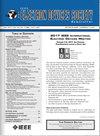Broadband Noise Characterization of SiGe HBTs Down to 4K
IF 2.4
3区 工程技术
Q3 ENGINEERING, ELECTRICAL & ELECTRONIC
引用次数: 0
Abstract
This paper provides a comprehensive analysis of the DC and RF behavior of HBTs, spanning temperatures from 350 to 3.8 K. It underscores the necessity of detailed studies for the design of RF circuits for quantum computing, including LNAs, VCOs, and mixers, due to the absence of cryogenic models. The DC gain shows betas of 800 at room temperature (RT) and 3000 at 3.8 K. RF characterization indicates a maximum fT of 500 GHz at 3.8 K and 300 GHz at RT. The proposed figure-of-merit, (gm.fT/Ic), typically used in CMOS design, is explored across the temperature range. The study reveals a noise equivalent temperature of sub-1 K at 3.8 K with source matching. The noise behavior of Si/SiGe:C HBTs within低至4K的SiGe hbt宽带噪声特性
本文提供了从350到3.8 K温度范围内HBTs的直流和射频行为的综合分析。由于缺乏低温模型,它强调了对量子计算RF电路设计进行详细研究的必要性,包括lna, vco和混频器。直流增益在室温下为800,在3.8 K时为3000。RF特性表明,在3.8 K时最大fT为500 GHz,在rt时最大fT为300 GHz。在整个温度范围内,研究了通常用于CMOS设计的性能因数(gm.fT/Ic)。研究发现,在3.8 K下,源匹配的噪声等效温度低于1 K。在$0.13~{\mu}$ m BiCMOS技术范围内,Si/SiGe:C hbt在293 ~ 4 K和10 kHz ~ 12 GHz范围内的噪声特性。分析表明,在4 K时,闪烁噪声系数K和角频率降低显著增加。高频参数fT达到500 GHz,与先进的CMOS节点相比表现出更好的性能。这项研究支持了HBTs的建模,这对于在低温下工作的电路至关重要。这些模型对于设计经典-量子接口特别有用。
本文章由计算机程序翻译,如有差异,请以英文原文为准。
求助全文
约1分钟内获得全文
求助全文
来源期刊

IEEE Journal of the Electron Devices Society
Biochemistry, Genetics and Molecular Biology-Biotechnology
CiteScore
5.20
自引率
4.30%
发文量
124
审稿时长
9 weeks
期刊介绍:
The IEEE Journal of the Electron Devices Society (J-EDS) is an open-access, fully electronic scientific journal publishing papers ranging from fundamental to applied research that are scientifically rigorous and relevant to electron devices. The J-EDS publishes original and significant contributions relating to the theory, modelling, design, performance, and reliability of electron and ion integrated circuit devices and interconnects, involving insulators, metals, organic materials, micro-plasmas, semiconductors, quantum-effect structures, vacuum devices, and emerging materials with applications in bioelectronics, biomedical electronics, computation, communications, displays, microelectromechanics, imaging, micro-actuators, nanodevices, optoelectronics, photovoltaics, power IC''s, and micro-sensors. Tutorial and review papers on these subjects are, also, published. And, occasionally special issues with a collection of papers on particular areas in more depth and breadth are, also, published. J-EDS publishes all papers that are judged to be technically valid and original.
 求助内容:
求助内容: 应助结果提醒方式:
应助结果提醒方式:


